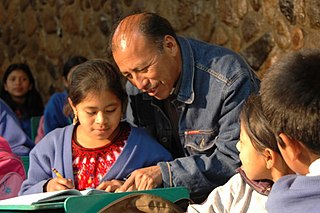Mam is a Mayan language spoken by about half a million Mam people in the Guatemalan departments of Quetzaltenango, Huehuetenango, San Marcos, and Retalhuleu, and the Mexican state of Chiapas. Thousands more make up a Mam diaspora throughout the United States and Mexico, with notable populations living in Oakland, California and Washington, D.C.

The Maya peoples are a large group of indigenous peoples of Mesoamerica. They inhabit southern Mexico, Guatemala, Belize, El Salvador and Honduras. The overarching term "Maya" is a collective designation that includes the peoples of the region which share some degree of cultural and linguistic heritage; however, the term embraces many distinct populations, societies and ethnic groups that each have their own particular traditions, cultures and historical identity.

Mesoamerican languages are the languages indigenous to the Mesoamerican cultural area, which covers southern Mexico, all of Guatemala and Belize and parts of Honduras and El Salvador and Nicaragua. The area is characterized by extensive linguistic diversity containing several hundred different languages and seven major language families. Mesoamerica is also an area of high linguistic diffusion in that long-term interaction among speakers of different languages through several millennia has resulted in the convergence of certain linguistic traits across disparate language families. The Mesoamerican sprachbund is commonly referred to as the Mesoamerican Linguistic Area.
Yucatec Maya, called mayaʼ tʼàan by its speakers, is a Mayan language spoken in the Yucatán Peninsula and northern Belize. To native speakers, the proper name is Maya and it is known only as Maya. The qualifier "Yucatec" is a tag linguists use to distinguish it from other Mayan languages. Thus the use of the term Yucatec Maya to refer to the language is scientific jargon or nomenclature.
The Chʼol (Chol) language is a member of the western branch of the Mayan language family used by the Chʼol people in the Mexican state of Chiapas. There are two main dialects:
Mayan Sign Language is a sign language used in Mexico and Guatemala by Mayan communities with unusually high numbers of deaf inhabitants. In some instances, both hearing and deaf members of a village may use the sign language. It is unrelated to the national sign languages of Mexico and Guatemala, as well as to the local spoken Mayan languages and Spanish.
Chuj is a Mayan language spoken by around 40,000 members of the Chuj people in Guatemala and around 3,000 members in Mexico. Chuj is a member of the Qʼanjobʼalan branch along with the languages of Tojolabʼal, Qʼanjobʼal, Akateko, Poptiʼ, and Mochoʼ which, together with the Chʼolan branch, Chuj forms the Western branch of the Mayan family. The Chujean branch emerged approximately 2,000 years ago. In Guatemala, Chuj speakers mainly reside in the municipalities of San Mateo Ixtatán, San Sebastián Coatán and Nentón in the Huehuetenango Department. Some communities in Barillas and Ixcán also speak Chuj. The two main dialects of Chuj are the San Mateo Ixtatán dialect and the San Sebastián Coatán dialect.

Many different languages are spoken in Mexico. The indigenous languages are from eleven distinct language families, including four isolates and one that immigrated from the United States. The Mexican government recognizes 68 national languages, 63 of which are indigenous, including around 350 dialects of those languages. The large majority of the population is monolingual in Spanish. Some immigrant and indigenous populations are bilingual, while some indigenous people are monolingual in their languages. Mexican Sign Language is spoken by much of the deaf population, and there are one or two indigenous sign languages as well.

Proto-Mayan is the hypothetical common ancestor of the 30 living Mayan languages, as well as the Classic Maya language documented in the Maya inscriptions. While there has been some controversy with Mayan subgrouping, there has been a general agreement that the following are the main five subgroups of the family: Huastecan, Yucatecan, Cholan-Tzeltalan, Kanjobalan-Chujean, and Quichean-Mamean.
Poqomam is a Mayan language, closely related to Poqomchiʼ. It is spoken by 50,000 or so people in several small pockets in Guatemala, the largest of which is in Jalapa department.
Qʼanjobʼal is a Mayan language spoken primarily in Guatemala and part of Mexico. According to 1998 estimates compiled by SIL International in Ethnologue, there were approximately 77,700 native speakers, primarily in the Huehuetenango Department of Guatemala. Municipalities where the Qʼanjobʼal language is spoken include San Juan Ixcoy, San Pedro Soloma, Santa Eulalia, Santa Cruz Barillas (Yalmotx), San Rafael La Independencia, and San Miguel Acatán. Qʼanjobʼal is taught in public schools through Guatemala's intercultural bilingual education programs.
Mochoʼ or Motozintleco is a moribund Mayan language spoken by the Motozintleco people of Chiapas, Mexico. It is part of the western branch of Mayan languages. Mochoʼ speakers refer to their own language as qatô:k, which means 'our language'. Mochoʼ has a dialect called Tuzantec spoken in Tuzantan, Chiapas.
The Academia de Lenguas Mayas de Guatemala, or ALMG is a Guatemalan organisation that regulates the use of the 22 Mayan languages spoken within the borders of the republic. It has expended particular efforts on standardising the various writing systems used. Another of its functions is to promote Mayan culture, which it does by providing courses in the country's various Mayan languages and by training Spanish-Mayan interpreters.
The Qʼanjobʼal (Kanjobal) are a Maya people in Guatemala. Their indigenous language is also called Qʼanjobʼal.

Intercultural bilingual education in Guatemala was begun as part of a 20th-century educational reform effort intended to promote the country's cultural diversity. The programs merge Mayan language and culture with Spanish language and Ladino culture, a shift from the assimilation policy of educational programs promoting Spanish literacy which reduce the use of indigenous languages. During the 20th century, education reform evolved from castilianization and the 1965 Bilingual Castilianization Program to the 1980 National Bilingual Education Project. Each program aimed to increase Spanish fluency. In 1985, the Constitution legalized bilingual education and the Ministry of Education formed the Programa Nacional de Educación Bilingüe (PRONEBI). PRONEBI developed from the 1980–1984 National Bilingual Education Project, and aimed to provide bilingual education for rural indigenous children.





